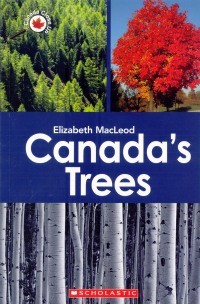| ________________
CM . . . . Volume XVIII Number 16 . . . . December 16, 2011
excerpt:
Award-winning author Elizabeth MacLeod provides a fascinating, easy to read book for young people to explore the trees of Canada. Following an introduction, entitled “Terrific Trees” that briefly explains the importance of trees in our lives, the reader discovers 10 chapters of fascinating information about this country’s native trees. Canada’s Trees includes a chapter devoted to each of 10 genera of trees, such as maples, firs, willows, oak and spruce. Each chapter in Canada’s Trees provides clear and interesting information. The physical characteristics of the trees, their location within Canada and numerous fascinating facts capture the reader’s interest. The larger font makes the short, well-spaced paragraphs easy to read. Interesting coloured fact boxes will further pique the reader’s interest. Providing some narrative examples helps the child make visual references to facts. Examples of this are that the Sitka spruce, Carmanah {carr-MANN-ah} is taller than a 30 storey building and that the Native people taught Jacques Cartier and his men to use the bark and leaves from the cedar to make a tea to save them from dying of scurvy. Full page and smaller photographs also provide pictorial information to complement the text. The species that make up each genus are listed in a separate fact box in each chapter. The inclusion of a glossary, pronunciation guides within the text, a simple index and a map showing provincial and territorial trees assists the young nonfiction reader in understanding the information. Canada’s Trees is not only an excellent reference for understanding the native trees of Canada, it is also a delightful reading experience. It will appeal to young readers’ curiosity about the world around them and will arouse further interest in our native trees and their human connection. Highly Recommended. Janice Foster is a retired teacher and teacher-librarian in Winnipeg, MB.
To comment
on this title or this review, send mail to cm@umanitoba.ca.
Copyright © the Manitoba Library Association. Reproduction for personal
use is permitted only if this copyright notice is maintained. Any
other reproduction is prohibited without permission.
NEXT REVIEW |
TABLE OF CONTENTS FOR THIS ISSUE
- December 16, 2011.
AUTHORS |
TITLES |
MEDIA REVIEWS |
PROFILES |
BACK ISSUES |
SEARCH |
CMARCHIVE |
HOME |
